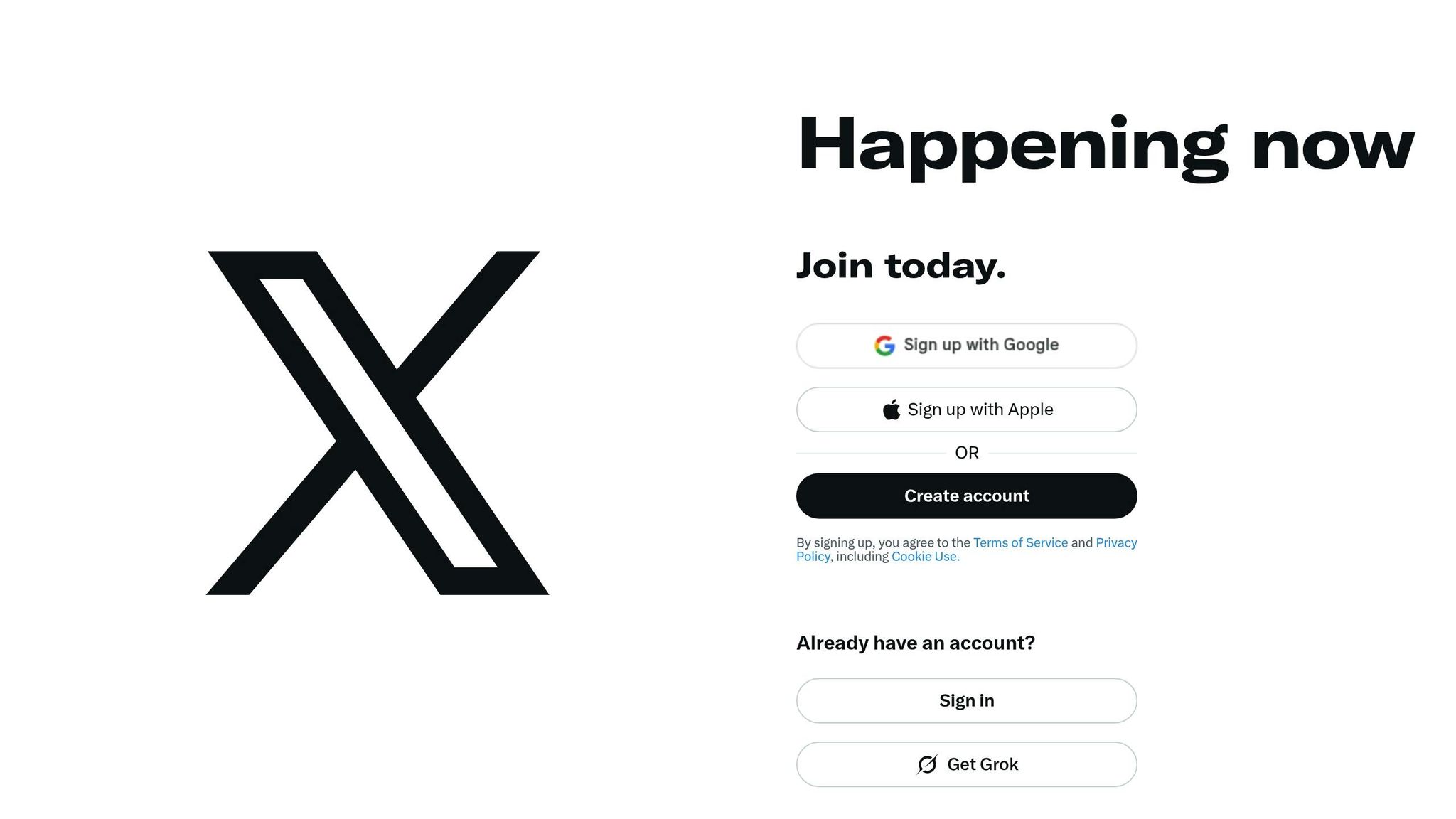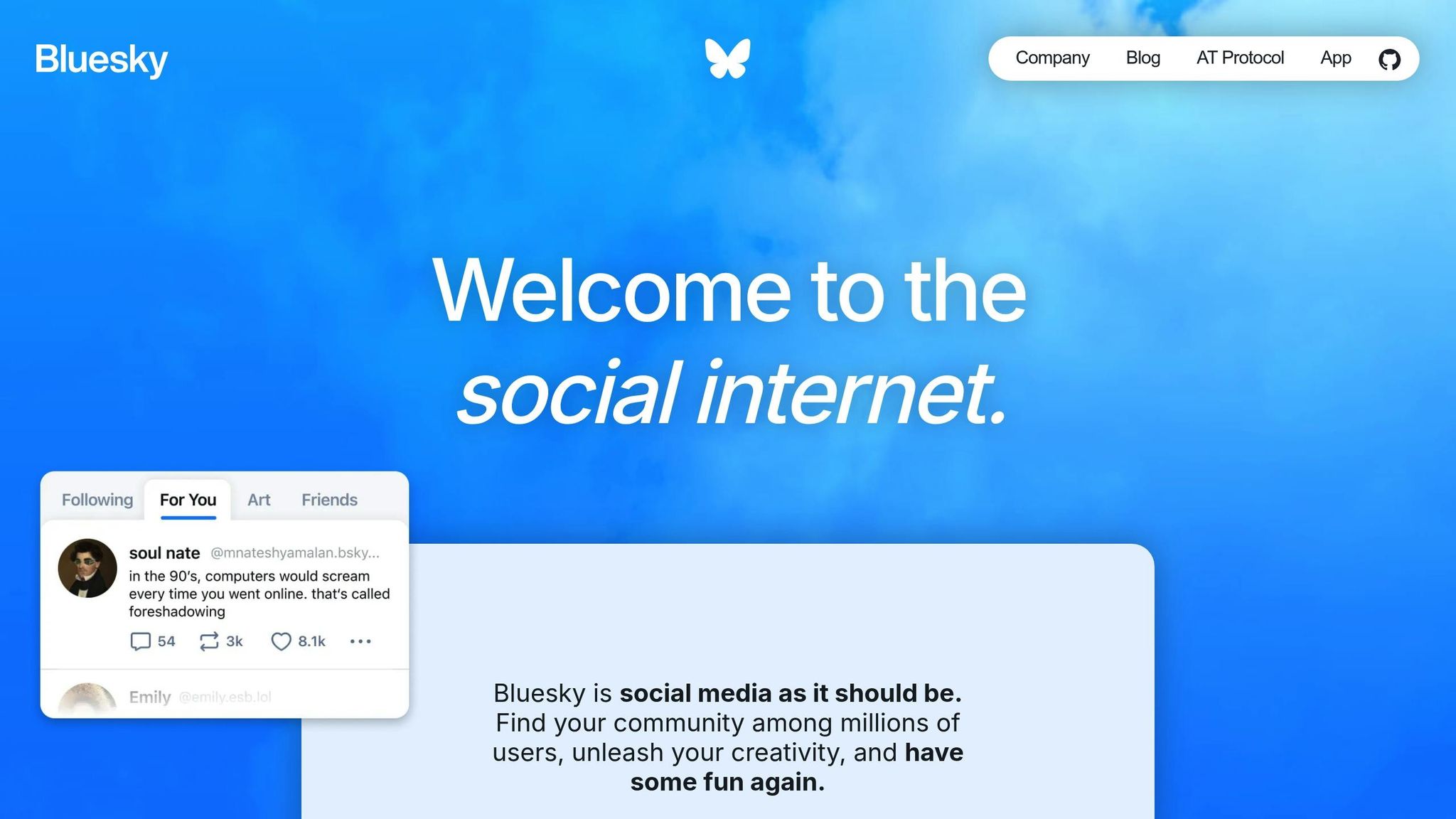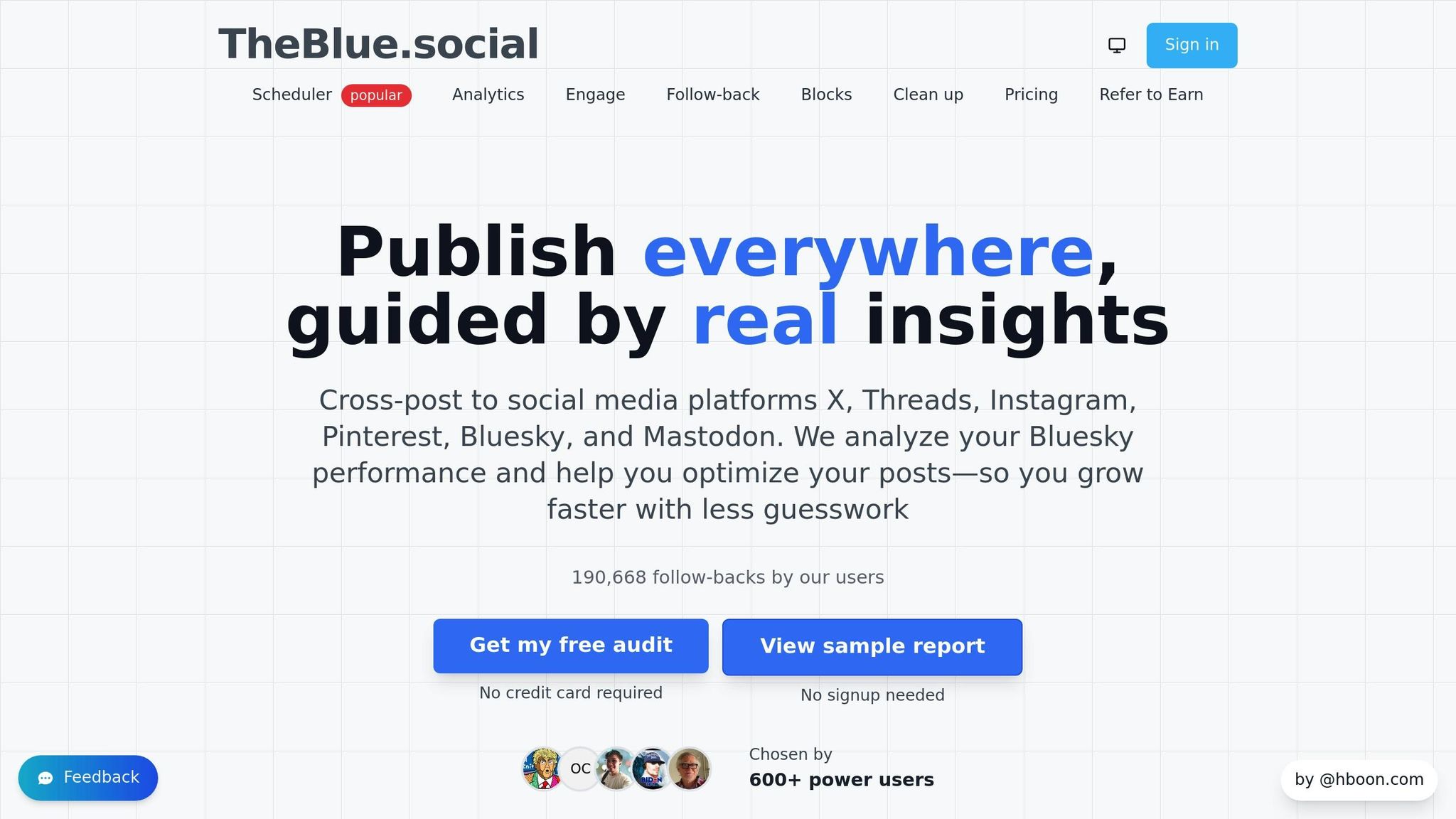X vs. Bluesky: Influencer Marketing Costs Compared
When planning influencer campaigns, X and Bluesky offer distinct cost structures and benefits. X (formerly Twitter) provides predictable pricing based on influencer size, with advanced analytics and a large user base of 586 million active users. Campaign costs on X are tied to metrics like cost per action, making it ideal for measurable results and broad reach.
In contrast, Bluesky focuses on organic collaborations with its smaller but engaged audience of 35.2 million users. Influencer pricing is flexible, often negotiated case-by-case, and engagement rates are reported to be 3-4 times higher than other platforms. However, Bluesky lacks native analytics, requiring third-party tools for ROI tracking.
Quick Comparison
| Feature | X (Twitter) | Bluesky |
|---|---|---|
| Active Users | 586 million | 35.2 million |
| Pricing Structure | Tiered (based on follower size) | Flexible, negotiated case-by-case |
| Engagement Rates | Standard | 3-4x higher than other platforms |
| Analytics | Robust native tools | Limited; relies on third-party tools |
| Best For | Broad reach, measurable results | Niche audiences, long-term partnerships |
Both platforms offer unique opportunities, but balancing budgets across them can help maximize reach while building deeper connections with audiences.
Influencer Pricing Explained: How Much Influencers Really Charge (2025 Guide)
Influencer Marketing Costs on X (Twitter)

To get a clear picture of how X operates, it’s important to understand its cost structure, especially when comparing it to Bluesky’s organic model. X has a well-established influencer marketing ecosystem, where pricing is tied to follower count and engagement quality. Thanks to its mature advertising framework, marketers in the U.S. can plan budgets with predictable costs based on different influencer categories.
Influencer Pricing by Follower Count
On X, influencer fees increase with audience size. Nano-influencers are the most budget-friendly option, while macro and mega influencers command higher fees due to their larger reach and more engaged followers. These tiered costs provide a foundation for dynamic negotiations when planning campaigns.
Price Negotiations and Payment Variables
The final price influencers charge often differs from initial quotes. Factors like campaign length, content complexity, and exclusivity agreements can influence rates. Long-term collaborations, in particular, tend to come with more favorable pricing, making them an attractive option for brands. Essentially, initial quotes are just the starting point for discussions.
Current X Influencer Pricing Trends
Recent shifts in influencer marketing on X reflect a growing demand for genuine, interactive content. This trend has prompted influencers to rethink their pricing strategies, aligning their fees with the value they provide through authentic engagement and creative campaigns.
Influencer Marketing Costs on Bluesky

Bluesky offers a different kind of influencer marketing environment compared to X. With around 33 million users as of early 2025, the platform lacks standardized pricing and formal advertising options. Instead, it thrives on organic, relationship-based collaborations, creating a unique cost structure that's quite distinct from X's more defined tiers.
No Standard Rate Cards
On Bluesky, there’s no such thing as a standard pricing guide. Unlike older platforms where influencer rates are typically tied to follower counts, Bluesky operates without formal monetization features like creator funds or ad revenue sharing programs [1]. This means influencer compensation is open to negotiation on a case-by-case basis.
The platform’s early-stage nature adds another layer of complexity. About half of its users have just one or no followers [1], making traditional follower-based pricing irrelevant. For marketers, this creates a landscape where building partnerships requires flexibility and creativity.
The Role of Organic Partnerships
Since Bluesky doesn't have a built-in advertising framework, influencer marketing takes center stage as the go-to promotional strategy. Many collaborations focus on product seeding or bartering, which can lower upfront costs while emphasizing long-term relationships.
Brands are shifting toward extended partnerships instead of one-off posts. While this strategy may reduce the cost per post, it often demands a bigger commitment overall. The focus on authenticity also means influencers are more selective about the brands they work with, which can lead to better audience engagement - even with smaller followings.
Challenges in Measuring ROI
Tracking return on investment (ROI) on Bluesky is tricky due to its limited native analytics. Unlike other platforms, Bluesky doesn’t offer the detailed metrics marketers typically use to evaluate campaigns. This makes it harder to justify spending on influencer marketing through traditional performance indicators. To fill the gap, brands often turn to third-party tools or manual tracking methods. For instance, TheBlue.social's analytics tools provide engagement and follower growth data that Bluesky itself doesn’t offer.
The lack of robust analytics also affects how brands plan budgets and measure success. Instead of focusing on direct sales, many brands prioritize goals like brand awareness and community engagement. Qualitative metrics, such as shifts in brand sentiment or the depth of community interaction, often take precedence over hard numbers when evaluating the impact of influencer partnerships on Bluesky.
sbb-itb-a73accb
Platform Cost Comparison and Budget Planning
When crafting influencer marketing budgets, understanding the key differences between X and Bluesky's cost structures is crucial. Each platform operates with its own unique approach, which directly influences how you allocate funds and plan campaigns.
Cost Structures: Standard vs. Flexible
X operates on a tiered pricing system based on an influencer's reach. Smaller influencers charge lower fees, while those with larger, more established audiences command higher rates. This straightforward structure makes it easier to estimate costs and compare proposals.
Bluesky, on the other hand, takes a more flexible approach. Some creators may accept non-monetary exchanges or modest fees, regardless of their audience size. While this can help lower initial costs, it complicates forecasting. However, as Bluesky matures, many creators are beginning to adopt more consistent pricing models. This evolving landscape requires brands to carefully analyze costs for each campaign.
Campaign Type Cost Analysis
Campaign expenses vary depending on the type of initiative and its objectives, and each platform offers distinct advantages.
For product launches, Bluesky often proves to be a cost-effective choice. Its focus on authentic recommendations and tight-knit community engagement allows brands to collaborate with multiple creators at a lower overall expense compared to a single influencer post on X.
Brand awareness efforts, however, may yield different results across platforms. X’s advanced metrics and precise targeting capabilities often justify higher spending when reaching specific audiences is critical. Meanwhile, Bluesky’s engaged communities can foster meaningful conversations and build genuine brand loyalty, making it ideal for cultivating long-term relationships.
For event promotion or time-sensitive campaigns, X typically leads the way. Its real-time nature and expansive reach make it perfect for quick visibility. Additionally, its well-established influencer networks allow for rapid scaling, which is essential for these types of initiatives.
Budget Allocation Tips
To get the most out of your marketing dollars, consider prioritizing investments on X for its measurable results and wide reach. At the same time, allocate a portion of your budget to experimenting with Bluesky. Starting with a smaller monthly budget on Bluesky can help you explore partnerships with various creators. Over time, focusing on building lasting relationships with these creators can improve results and streamline costs.
Using cross-platform management tools can also enhance efficiency. For example, TheBlue.social's cross-posting scheduler allows brands to maintain consistent messaging across X, Bluesky, and other platforms without the hassle of creating entirely separate content for each.
Lastly, measure success by tracking cost per engagement rather than cost per follower. While pricing models differ, Bluesky campaigns often deliver higher engagement rates, which can result in competitive costs for meaningful interactions. This metric provides a clearer picture of performance and helps you optimize your budget effectively.
Tools for Managing Influencer Campaigns and Measuring ROI
Using the right tools can make managing influencer campaigns smoother and more effective, especially when juggling platforms like X's established ecosystem and Bluesky's growing network. These tools not only simplify multi-platform campaigns but also help track performance, cut costs, and ensure data-driven decisions. They work hand-in-hand with cost-saving strategies by reducing manual work and clarifying ROI.
TheBlue.social Cross-Posting Scheduler

Manually cross-posting content across platforms is time-consuming and prone to inconsistencies. TheBlue.social's cross-posting scheduler solves this issue by letting brands and influencers manage content calendars for X, Bluesky, Instagram, Threads, Pinterest, and Mastodon - all from one dashboard.
This centralized approach streamlines collaboration with influencers active on multiple platforms. Instead of creating separate content briefs and timelines for each channel, brands can align messaging while allowing influencers to tailor posts for their specific audiences. The scheduler ensures consistency across campaigns while cutting down on administrative tasks that can inflate costs.
For campaigns with tight deadlines, the scheduler synchronizes posts across platforms, making coordinated launches hassle-free and efficient.
Bluesky Analytics Tools
While scheduling tools keep messaging on track, analytics tools provide the insights needed to measure success. Unlike X, which offers a robust metrics dashboard, Bluesky's native analytics are limited, making it harder to assess campaign performance and calculate ROI.
TheBlue.social's Bluesky analytics bridges this gap by delivering detailed engagement tracking, follower growth metrics, and other performance indicators. These insights help brands evaluate the real impact of their Bluesky influencer partnerships, moving beyond surface-level engagement numbers.
By tracking metrics like engagement rates, reach, and audience growth, these tools allow brands to compare cost-effectiveness across campaigns and make smarter budget decisions. For influencers, access to detailed performance data can help justify their rates and demonstrate their value to potential partners. As Bluesky's creator economy evolves, having reliable analytics could lead to more standardized pricing models.
Free Campaign Planning Tools
Planning influencer campaigns involves countless small tasks, and TheBlue.social offers free tools to make this process faster and more cost-effective.
- Handle Availability Checkers: Quickly verify influencer handles on Bluesky and X during the vetting process.
- Hashtag Generator: Optimize content with relevant hashtags.
- Emoji Integration Tool: Maintain a consistent brand voice across posts.
Though these tools may seem minor, they save time and streamline workflows, especially when managing multiple influencer partnerships. The result? Faster execution and meaningful cost savings.
One standout tool is the Open Graph preview feature. For campaigns involving link sharing, it allows teams to preview how content will appear across platforms before launch. This prevents costly post-launch fixes and ensures a polished, consistent brand presentation right from the start.
Conclusion
To wrap up the cost comparison of influencer marketing on X and Bluesky, it’s clear that each platform brings its own unique pricing structure and opportunities. X operates with a tiered pricing model tied to audience size, making it a good fit for brands prioritizing immediate reach and detailed analytics. On the other hand, Bluesky offers a more informal and negotiable pricing environment, which can be appealing for brands looking to establish meaningful partnerships without breaking the bank. With its growing user base of 35.2 million users (source), Bluesky is becoming an intriguing option for marketers.
When choosing between the two, align your goals with the platform’s strengths. If you’re after measurable results and a structured approach, X’s higher costs might be worth it. But if your focus is on cultivating authentic connections and tapping into emerging audiences, Bluesky’s flexibility and evolving tools, like TheBlue.social's analytics, can help offset its current limitations in data tracking.
A balanced strategy - leveraging both platforms and using cross-posting tools - can maximize your reach and prepare your campaigns for both short-term results and long-term growth. As Bluesky continues to grow and possibly formalizes its pricing, early adopters who’ve already built a presence and utilized cross-platform analytics will be ahead of the curve.
FAQs
::: faq
How can brands track ROI on Bluesky without built-in analytics?
Brands looking to measure ROI on Bluesky have a couple of effective approaches at their disposal. One option is to use third-party tools that offer analytics for tracking engagement, follower growth, and other important metrics. These tools can provide a clearer picture of how campaigns are performing.
Another method involves manual tracking. By keeping an eye on follower trends, monitoring engagement rates, and leveraging UTM codes, brands can track traffic and conversions through platforms like Google Analytics.
Even without built-in analytics on Bluesky, these methods empower businesses to assess campaign performance and ROI, helping them make smarter decisions about their influencer marketing strategies. :::
::: faq
What are the benefits of using both X and Bluesky for influencer marketing?
Using X and Bluesky together for influencer marketing gives brands the chance to tap into the unique strengths of each platform. X stands out with its vast audience and robust advertising features, making it perfect for reaching a broad audience and driving large-scale awareness. On the other hand, Bluesky focuses on fostering tight-knit, community-driven interactions, which can lead to more genuine engagement with specific, niche groups.
By blending these platforms, you can maximize visibility through X's expansive reach while cultivating meaningful, authentic connections on Bluesky. This combination not only enhances engagement but also builds trust, ultimately leading to better outcomes for your marketing efforts. :::
::: faq
How can brands negotiate influencer fees on Bluesky effectively?
On Bluesky, brands usually handle influencer fees through direct conversations with the influencers themselves. These discussions often revolve around important factors like the influencer's follower count, engagement levels, and the overall scope of the campaign. Key points include agreeing on compensation, outlining content expectations, and setting up a posting schedule.
Bluesky’s flexible pricing approach allows both brands and influencers to tweak terms to fit their needs. This might mean including extra perks or customizing campaign details. Establishing open and cooperative communication is key to creating agreements that work well for both sides. :::